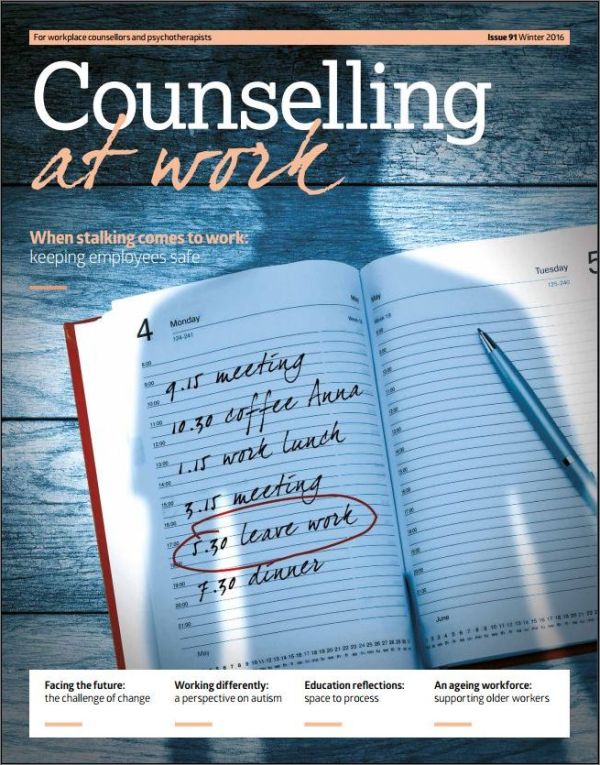In this issue
Features
When stalking comes to work (free article)
The workplace can be one of the most dangerous places for victims of stalking. Rachel Horman explains how employers can safeguard against it
Working differently
Fitting in at work can be a minefield for employees on the autism spectrum. Valerie Sutherland suggests ways that therapists and employers can help
Reflections in education
Alex Pearse reports on a pilot project to provide reflective practice supervision to staff in education
Regulars
Workplace matters (free article)
Sandi Mann – An awkward triangle?
Talking purple (free article)
Sarah Simcoe – Getting purple talent back to work
Cyberwork
Sarah Worley-James – The power of words
EAP matters
Timmy Kurtuldum – The magic art of mediation
Practitioner matters
Jennie Cummings-Knight – An ageing workforce

A pdf version of this issue is available from the Counselling at Work archive
First words
We are all creatures of habit, and stalkers rely on this, writes Rachel Horman in a disturbing article on the prevalence of stalking at work. The Home Office recently announced new Stalking Protection Orders which, it’s hoped could save lives by intervening earlier to prevent obsessive behaviour from escalating. Work is one place where the victim can reliably be found, and it’s also a potentially rich source of information. A careless conversation, too much information on an out-of-office notice, or a stalker having access to confidential data, can potentially put employees at risk. Certain occupations, such as health professionals, are particularly vulnerable to the risk of stalking, due to their constant contact with the public.
As Chair of Paladin, the National Stalking Advocacy Service, Rachel Horman explains how employers can reduce risk to employees and she provides helpful steps to support traumatised victims. Shockingly, the average victim has experienced 100 incidents before reporting it to the police. A pattern of silence is horribly familiar in the stories we as counsellors hear from survivors of abuse, which contributes to the persistence of abusers. Laura Bates, of The Every Day Sexism Project,1 wrote recently of the epidemic of sexual assaults in schools. Girls left covered in bruises after sexual assaults in schools, and who did not tell a teacher because they didn’t think anybody would believe them. Horrifyingly, five-and-a-half thousand alleged sexual offences (including 600 rapes) had been reported to police as having occurred in schools over three years, and one in three 16 to 18-year-old girls had experienced ‘unwanted sexual touching’ at school.2
Schools have always been a frontline for the social issues affecting children and young people across the country. However, the backdrop of austerity and cuts to vital support services, mean that staff in education have been reporting growing pressures to respond to the mental health crisis in children and young people. Alex Pearse explains in ‘Reflections in education’ how an innovative pilot project was set up in schools and colleges in Gloucestershire, to provide pastoral staff with a safe reflective space to process the troubling material they hold. Counsellors used their supervision skills to support staff to feel more resilient and better equipped to support the needs of children and young people. The staff’s feedback about the value of this relatively small amount of time and space for reflective supervision is humbling.
I was fascinated to read Valerie Sutherland’s article, Working differently, about her experiences with autism in her family. Using her personal insight, she’s developed an area of expertise supporting businesses and the workplace to understand neurodiversity. I was reminded of clients I’ve known who’ve expressed bewilderment at demands made of them that they should hot-desk, adapt to constant change and be able to meet an ever increasing list of competences that don’t come naturally. Valerie writes sensitively about how to minimise anxiety and create a working environment where the AS employee or client can feel valued and understood.
I welcome two new writers in this issue: In Talking purple, Sarah Simcoe asks if we are all doing enough to help people with a disability to get back into work. Sarah identifies steps employers can take to create and foster a truly diverse and talented workplace. Co-ordinating the Online Counselling Service at Cardiff University, Sarah Worley-James is well placed to take over as the writer for Cyberwork, considering the relationship between technology and therapy. At the end of last year, you may have heard about the 89-year-old man who put an advert in his local paper asking someone to give him a job to save him from dying of boredom. The last I heard, he’d started work in a local café. As a third of British workers will be over 50 by 2020, there’s a serious point to what appeared as a rather light-hearted story. With an ageing society living longer and working longer, we need to address how we’re going to adapt to our ageing workforce. You’ll know that one of BACP’s aims is to reach out to older people, so if you or your organisation is working to respond to the needs of older clients and employees, I’d be interested to hear from you. Jennie Cummings-Knight offers her perspective on this topic in Practitioner matters.
Finally, if writing is on your list of things to do this year and you have a potential idea for an article, I hope you’ll drop me a line and let me know what’s on your mind.
Nicola Banning, editor
counsellingatwork@bacp.co.uk
References
1 The everyday sexism project. [Online.] http://everydaysexism.com/
2 Bates L. There’s an epidemic of sexual assaults in our schools. Yet nothing is done. The Guardian 2016; 29 November. [Online.] https://www.theguardian.com/commentisfree/2016/nov/29/epidemic-sexual-assaults-schools-gropedpornographic-images-slags (accessed 1 December 2016).
